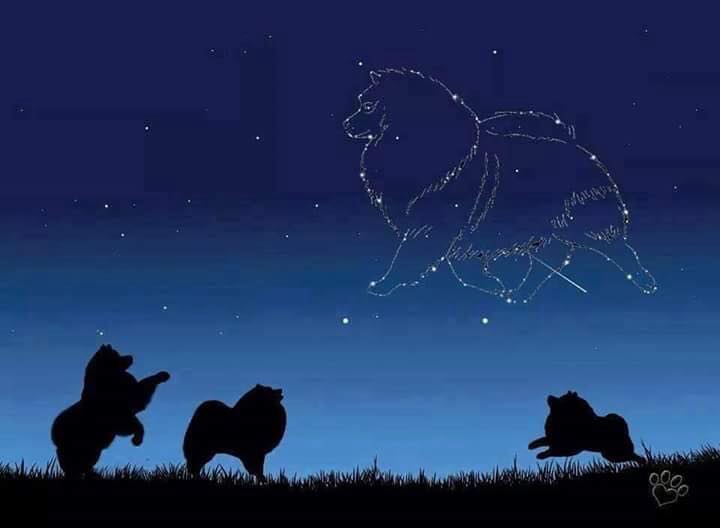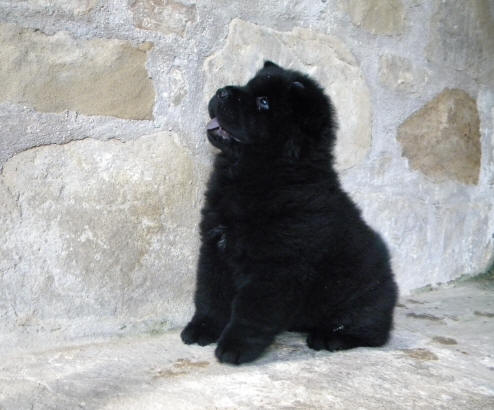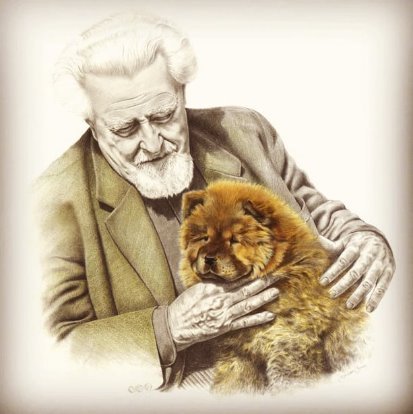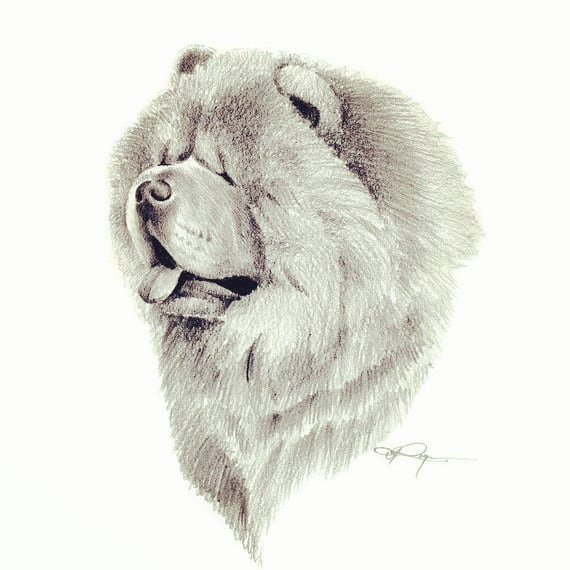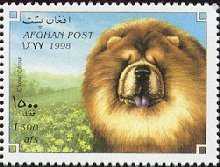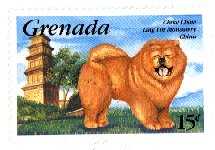Storia del Chow Chow
di Marcello Ciai
Una deliziosa antica fiaba racconta che: mentre Dio dipingeva di blu il cielo, un Chow Lo seguiva e puliva con la lingua le gocce che cadevano. In tutte le favole c'è qualcosa di vero. Ed in questa è vero che il Chow ha la lingua blu e le sue origini sembrano iniziare con la Creazione di Dio.
Una deliziosa antica fiaba racconta che: mentre Dio dipingeva di blu il cielo, un Chow Lo seguiva e puliva con la lingua le gocce che cadevano. In tutte le favole c'è qualcosa di vero. Ed in questa è vero che il Chow ha la lingua blu e le sue origini sembrano iniziare con la Creazione di Dio.
by Marcello Ciai
A lovely ancient fairy-tale tells that while God was painting the sky blue, a Chow Chow was following Him and licked up the drops that fell with his tongue. There is some truth in all fairy-tales, and in this one it is true that the Chow has a blue tongue and that his origins begin with God's Creation !
A lovely ancient fairy-tale tells that while God was painting the sky blue, a Chow Chow was following Him and licked up the drops that fell with his tongue. There is some truth in all fairy-tales, and in this one it is true that the Chow has a blue tongue and that his origins begin with God's Creation !
Nessuno storico cinofilo finora ha potuto dare una data, un tempo certo alle sue origini.
"Oriental Masterpiece" - Capolavoro Orientale, lo definisce un sito Internet americano. Sappiamo infatti per certo che viene dall' Oriente, ma non sappiamo per certo né il paese d'origine, anche se molti concordano per la Mongolia, né la nazione d'arrivo in Europa, anche se molti indicano
l'Inghilterra. Ho letto in un articolo del Chow-Chow Club Olandese che addirittura fu Marco Polo a descrivere il Chow-Chow in Occidente nella seconda meta del 13° Secolo.
"Oriental Masterpiece" - Capolavoro Orientale, lo definisce un sito Internet americano. Sappiamo infatti per certo che viene dall' Oriente, ma non sappiamo per certo né il paese d'origine, anche se molti concordano per la Mongolia, né la nazione d'arrivo in Europa, anche se molti indicano
l'Inghilterra. Ho letto in un articolo del Chow-Chow Club Olandese che addirittura fu Marco Polo a descrivere il Chow-Chow in Occidente nella seconda meta del 13° Secolo.
Up till now there isn't any historical dog-fancier who could give a date or a definite period to his origins. An American Internet-site defines him as the "Oriental Masterpiece". In fact we know for sure that he comes from the East (the Orient), but we don't know for sure either his native land- though many agree upon Mongolia - or the European nation where he first arrived – though many writers say it was England. I read in an article of the Dutch Chow Chow Kennel Club that even Marco Polo in the second half of the XIII century here in the West (Occident), already had given a description of the Chow-Chow.
Io sono stato cacciatore e ho pure addestrato cani da difesa, ma non ho visto mai cani tirar fuori fagiani, lepri e cinghiali come il Chow Chow; come pure senza che gli fosse stato insegnato nulla ho visto un chow blue attaccare una persona indesiderata in maniera fantastica, mi sembrava veramente di assistere a una scena irreale di Walt Disney, gli saltò al braccio come un proiettile.
Gli Inglesi se ne sono innamorati per primi in Europa. Fin dall'inizio del 19° Secolo, era stato presentato allo Zoo di Londra come cane "mezzo selvatico"; nel 1880 apparve per la prima volta ad un'esposizione e solamente 10 anni dopo veniva riconosciuto dal Kennel Club.
Nel 1895 fu fondato il primo Chow-Chow Club Inglese che ne stabilì lo standard.
Chow Chow hanno figurato e figurano tutt'oggi su pacchetti di sigarette, su confezioni di té, su carte da gioco, su cartoline d'augurio, buste e francobolli. Francobolli con chow chow risultano emessi anche recentemente dai più svariati paesi del mondo, dall'Africa alla Russia.
Gli Inglesi se ne sono innamorati per primi in Europa. Fin dall'inizio del 19° Secolo, era stato presentato allo Zoo di Londra come cane "mezzo selvatico"; nel 1880 apparve per la prima volta ad un'esposizione e solamente 10 anni dopo veniva riconosciuto dal Kennel Club.
Nel 1895 fu fondato il primo Chow-Chow Club Inglese che ne stabilì lo standard.
Chow Chow hanno figurato e figurano tutt'oggi su pacchetti di sigarette, su confezioni di té, su carte da gioco, su cartoline d'augurio, buste e francobolli. Francobolli con chow chow risultano emessi anche recentemente dai più svariati paesi del mondo, dall'Africa alla Russia.
I was a hunter and also a dog-trainer of hunting- and watch-dogs, but I've never seen dogs draw out pheasants, hares and wild boars like Chows do, even without being trained. I once saw a blue Chow attack an unwelcome person in an incredible way, it was like fantastic scene from Walt Disney, he jumped up at the intruder’s arm like a bullet. The English were the first in Europe who fell in love with this breed. From the beginning of the XIX century, the Chow was presented at London Zoo, like a "half-savage" dog; in 1880 he appeared for the first time at a dog-show and only 10 years later the Kennel Club recognized this breed. In 1895 the first English Chow-Chow Club was founded, which also established the standard of the breed. The Chow-Chow appeared and right up to today appears on packets of cigarettes, on packets of tea, playing-cards, postcards, envelopes and stamps - stamps with the image of the Chow-Chow have been recently issued from a whole host nations of the world, from Africa to Russia.
Standard
This is Il suo standard attuale, riconosciuto falla F.C.I. ha alcune importanti differenze da quello antico. Infatti sul retro di una "card" inserita in pacchetti da dieci sigarette inglesi del 1937 si legge: Un cane di origine cinese di costruzione possente. Cranio molto largo e piuttosto piatto con la faccia fino all'estremità di moderata lunghezza. Muso marcato e largo. Tartufo nero e largo (nei colori chiari è ammesso un naso rosa). Occhi scuri, profondi e piccoli, situati obliquamente (occhi chiari ammessi nei blue). Orecchie piccole e dritte a triangolo. L'espressione dev'essere imbronciata (scowl).
Collo corto, molto forte e circondato da un folto collare di pelliccia. Dorso corto e forte. Torace molto profondo, con costole ben disegnate e rene possente.
Zampe anteriori appiombo e di buona ossatura. Zampe posteriori muscolose e garretti dritti; piedi tondi e piccoli .
Pelliccia abbondante, folta e resistente alle intemperie, sottopelo lanoso. Altezza al garrese da 40 a 54 cm. ( 17 - 21 inches). Peso tra le 55 - 60 lbs = 25 - 28 kg. Colori: nero, rosso, giallo, blu e bianco (ma non chiazzato).
Nelle differenze tra l'antico e il moderno notiamo che il collo dello standard attuale non dev'essere corto, nel primo invece è corto; ma aggiungo io, armoniosamente ben impiantato sulle spalle con una netta piegatura (circa 60°).
Il suo peso ideale è sui 23-28 kg. secondo il sesso.
Oggi vediamo giudici che sulla scia americana, fanno diventare campioni cani di altezza e peso, ingiustificatamente ed eccessivamente superiore allo standard stesso. Così addio a certe sue caratteristiche come il "double-hock", sua brillante andatura "sui trampoli".
Sul suo temperamento e carattere: riflessivo, tranquillo, dignitoso, impassibile e diffidente è stato e viene scritto tanto. E' bene però sottolineare che la "personalità" del Chow è molto diversa dagli altri cani, e le sue attitudini sono più paragonabili a quelle dei migliori gatti.
Mi interessa sempre leggere o sentire cosa ne pensano gli altri tutti, addetti e non addetti; perchè il Chow è molto versatile ed ognuno può scoprire qualcosa di nuovo, mentre invece difficilmente qualcuno gli può insegnare qualcosa. Chi sceglie un Chow, sceglie una personalità.
Collo corto, molto forte e circondato da un folto collare di pelliccia. Dorso corto e forte. Torace molto profondo, con costole ben disegnate e rene possente.
Zampe anteriori appiombo e di buona ossatura. Zampe posteriori muscolose e garretti dritti; piedi tondi e piccoli .
Pelliccia abbondante, folta e resistente alle intemperie, sottopelo lanoso. Altezza al garrese da 40 a 54 cm. ( 17 - 21 inches). Peso tra le 55 - 60 lbs = 25 - 28 kg. Colori: nero, rosso, giallo, blu e bianco (ma non chiazzato).
Nelle differenze tra l'antico e il moderno notiamo che il collo dello standard attuale non dev'essere corto, nel primo invece è corto; ma aggiungo io, armoniosamente ben impiantato sulle spalle con una netta piegatura (circa 60°).
Il suo peso ideale è sui 23-28 kg. secondo il sesso.
Oggi vediamo giudici che sulla scia americana, fanno diventare campioni cani di altezza e peso, ingiustificatamente ed eccessivamente superiore allo standard stesso. Così addio a certe sue caratteristiche come il "double-hock", sua brillante andatura "sui trampoli".
Sul suo temperamento e carattere: riflessivo, tranquillo, dignitoso, impassibile e diffidente è stato e viene scritto tanto. E' bene però sottolineare che la "personalità" del Chow è molto diversa dagli altri cani, e le sue attitudini sono più paragonabili a quelle dei migliori gatti.
Mi interessa sempre leggere o sentire cosa ne pensano gli altri tutti, addetti e non addetti; perchè il Chow è molto versatile ed ognuno può scoprire qualcosa di nuovo, mentre invece difficilmente qualcuno gli può insegnare qualcosa. Chi sceglie un Chow, sceglie una personalità.
Standard
The current standard, recognized by the F.C.I. ( Fédération Cynologique Internationale) shows some important differences from the original one. In fact, on the back of a postcard, included in a packet of 10 cigarettes of 1937, you could read : " A dog of Chinese origin of powerful construction. Skull very broad and rather flat with a face of moderate length. The muzzle is pronounced and broad. A black and large nose (for lighter colours a clear nose is permitted). Dark, deep and small eyes, obliquely situated (clear eyes are permitted for the blue). The ears are small and straight, kept like a triangle. His grumpy expression gives that characteristic "scowl". Short neck, very strong and encircled with a huge ruff of fur. The back is short and strong. The fore legs are perpendicularly and of good bone. The hind legs muscularly with straight haunches, small and rounded feet. Fur abundantly, thick and weatherproof, woolly undercoat. Height from 40 to 54 cm (17-21 inches). Weight between 55-60 lbs (25 to 28 kgs). Colour: black, red, fawn, blue, white (but not part-colours). From the differences between the old and the modern standard we notice that in the current one the neck hasn't to be short, while instead for the old standard the neck is short. I do add though that the neck has to be solidly implanted on the shoulders with a clean-off bend (about 60°) but all in a harmonious way. His ideal weight is about 23 to 28 kgs (55 to 60 lbs) according to the sex. Today we see judges who, following the American scheme, pronounce dogs champions with a height and a weight, unjustified and exceedingly superior to the standard.
In this way you can say goodbye to certain characteristics like e.g. "double-hock" his brilliant way of stilted walking. As to his temperament and behaviour, he can variously be described as:- reflective, quiet, noble, impassive and wary. A lot has been and is still being written, and it is good to underline the personality of the Chow. His character is very different from other dogs, and his attitude and personality can best be compared with those of the finest cats.
It always interests me to read or to listen to what others think about the Chow - insiders and outsiders - because the Chow is very versatile and each one can discover something new, while on the contrary it is very difficult that someone can teach him something. He who chooses a Chow, chooses a personality.
In this way you can say goodbye to certain characteristics like e.g. "double-hock" his brilliant way of stilted walking. As to his temperament and behaviour, he can variously be described as:- reflective, quiet, noble, impassive and wary. A lot has been and is still being written, and it is good to underline the personality of the Chow. His character is very different from other dogs, and his attitude and personality can best be compared with those of the finest cats.
It always interests me to read or to listen to what others think about the Chow - insiders and outsiders - because the Chow is very versatile and each one can discover something new, while on the contrary it is very difficult that someone can teach him something. He who chooses a Chow, chooses a personality.
Alcune curiosità: in Manciuria e Mongolia gli agricoltori davano
i Chow in dote alle figlie; l'Imperatore Ling-Ti, oltre 3000 anni fa, teneva i Chow come membri della sua famiglia imperiale,
con tanto di servitù, e li insigniva di titoli, ordini ed noreficenze. Un'altro imperatore teneva i Chow come guardiani per i suoi numerosissimi bambini. In un mondo come quello di oggi in cui si sente che perfino i cani straziano dei bambini, io devo testimoniare che in circa 30 anni di allevamento del Chow-Chow, con i miei 10 figli e i loro amichetti, che hanno vissuto e vivono tutt'ora in continuo stretto contatto con cuccioli e adulti di questa razza, non ho mai visto un Chow rivoltarsi a un bambino. Certo non è un cane per tutti ! Sicuramente non è adatto ad una famiglia dove regnano tensioni ed disarmonie, prima o poi questo porterà ad indifferenza o peggio ancora ad aggressività. Per alcuni problemi dati da qualche soggetto e dovuti, si dice, al suo temperamento, le cause si devono attribuire paradossalmente ai periodi di maggior popolarità di questa razza. Mi spiego: la razza ha passato due periodi di grande "popolarità": uno nel 1930, quando il Presidente degli U.S.A. Calvin Cooledge teneva un Chow di nome Timmy, alla Casa Bianca; un'altro negli anni '80, e anche attualmente la razza vive un periodo di questo genere. Purtroppo in questi periodi nella foga di far cuccioli chow per speculare sulla loro aumentata richiesta, allevatori e commercianti senza scrupoli, usano soggetti con temperamento e carattere non adatto per la riproduzione. Un allevatore responsabile, appassionato della razza, con lunga esperienza e onesto, rifiuta di usare soggetti che sono per esempio aggressivi o timidi. La complessità del carattere del Chow, interessò perfino Siegmund Freud che si mise ad allevarlo e dopo la sua morte la sua figlia Anna ha continuato l'allevamento. Sfido qualunque altra razza ad essere più utile all'uomo del Chow. Infatti il Chow è servito e serve ancora nei suoi paesi d'origine agli scopi più vari: dalla protezione al trasporto, dalla caccia all'alimentazione, dall'abbigliamento comune alla pelliccia dei Mandarini.
Voglio concludere come ho iniziato mettendo il Chow vicino a Dio e ricordando che qualcosa ce l'ha a che fare col cielo se fin dall'antichità i monaci orientali lo mettevano a guardia dei templi per difendersi anche dagli spiriti maligni.
In un recente bellissimo francobollo dell' isola di Grenada, il Chow Chow è gemellato con il magnifico Monastero di Ling Yin in Cina.
i Chow in dote alle figlie; l'Imperatore Ling-Ti, oltre 3000 anni fa, teneva i Chow come membri della sua famiglia imperiale,
con tanto di servitù, e li insigniva di titoli, ordini ed noreficenze. Un'altro imperatore teneva i Chow come guardiani per i suoi numerosissimi bambini. In un mondo come quello di oggi in cui si sente che perfino i cani straziano dei bambini, io devo testimoniare che in circa 30 anni di allevamento del Chow-Chow, con i miei 10 figli e i loro amichetti, che hanno vissuto e vivono tutt'ora in continuo stretto contatto con cuccioli e adulti di questa razza, non ho mai visto un Chow rivoltarsi a un bambino. Certo non è un cane per tutti ! Sicuramente non è adatto ad una famiglia dove regnano tensioni ed disarmonie, prima o poi questo porterà ad indifferenza o peggio ancora ad aggressività. Per alcuni problemi dati da qualche soggetto e dovuti, si dice, al suo temperamento, le cause si devono attribuire paradossalmente ai periodi di maggior popolarità di questa razza. Mi spiego: la razza ha passato due periodi di grande "popolarità": uno nel 1930, quando il Presidente degli U.S.A. Calvin Cooledge teneva un Chow di nome Timmy, alla Casa Bianca; un'altro negli anni '80, e anche attualmente la razza vive un periodo di questo genere. Purtroppo in questi periodi nella foga di far cuccioli chow per speculare sulla loro aumentata richiesta, allevatori e commercianti senza scrupoli, usano soggetti con temperamento e carattere non adatto per la riproduzione. Un allevatore responsabile, appassionato della razza, con lunga esperienza e onesto, rifiuta di usare soggetti che sono per esempio aggressivi o timidi. La complessità del carattere del Chow, interessò perfino Siegmund Freud che si mise ad allevarlo e dopo la sua morte la sua figlia Anna ha continuato l'allevamento. Sfido qualunque altra razza ad essere più utile all'uomo del Chow. Infatti il Chow è servito e serve ancora nei suoi paesi d'origine agli scopi più vari: dalla protezione al trasporto, dalla caccia all'alimentazione, dall'abbigliamento comune alla pelliccia dei Mandarini.
Voglio concludere come ho iniziato mettendo il Chow vicino a Dio e ricordando che qualcosa ce l'ha a che fare col cielo se fin dall'antichità i monaci orientali lo mettevano a guardia dei templi per difendersi anche dagli spiriti maligni.
In un recente bellissimo francobollo dell' isola di Grenada, il Chow Chow è gemellato con il magnifico Monastero di Ling Yin in Cina.
There are many curiosities about the Chows heritage and ancestry; in Manchuria and Mongolia the farmers gave their daughters Chows as a dowry; The Emperor Ling-ti, who lived more than 3.000 years ago, kept the Chows as members of his imperial family, with so many servants, and he awarded them with titles, orders and decorations. Another emperor kept the Chows as guards for his great number of children. In a world of today in which you hear that even dogs lacerate children, I have to testify that in about 30 years of Chow-Chow breeding, my children and their friends, who lived and still live in continuous and close contact with puppies and adults of this breed, I've never seen a Chow that turned on a child. However, it’s true to say that it is not a dog for everyone ! He surely doesn't fit in a family where tension and disharmony reigns; this will bring sooner or later to indifference or worse of all to aggressiveness. For problems, given by some subjects, and as they say due to his temperament, you have to ascribe its causes paradoxically to the periods of great popularity of this breed. I'll explain myself: the Chow has passed two periods of great popularity that is the first one in 1930, when the President of the U.S.A. Calvin Cooledge had a Chow at the White House, named Timmy; another period in the 80's and also actually this breed lives a period of that kind.. Unfortunately during these periods, in the impetuosity of having puppies for speculation on their increased demand, unscrupulous breeders and traders, used dogs with a temperament and a character not qualified for reproduction. A keen and responsible breeder of the Chow, with a long and honest experience, refuses to use subjects which are, for example, shy or aggressive. The complexity of the Chow's character interested even Siegmund Freud who began to breed them and after his death his daughter Anna continued to breed them thereafter. I challenge any other breed to be more useful to man than the Chow, in fact in his native land he has served and still serves most various aims: from protection to transport, from hunting to food, from the common clothing-industry to fur coats for the Mandarins. I like to conclude the way I started, putting the Chow close to God and recalling that he has something to do with Heaven if from ancient times they put him as a guard before the temples to defend themselves from evil spirits too. In a recent wonderful stamp of the Isle of Grenada, the Chow-Chow is twinned with the magnificent monastery of Ling Ying in China.
